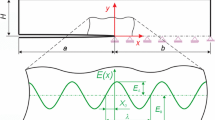Abstract
Methods of utilizing dynamic photoelasticity with fracture-type specimens to simultaneously determine the stress-intensity factorK Iand the crack-tip velocity are reviewed. Problems associated with data analysis to obtainK Ifrom isochromatic-fringe loops are discussed. Errors resulting from the use of static near-field equations in the method of analysis are considered and a correction method is developed. Finally, the invariance ofK Im(the minimumK required to maintain a finite crack velocity) is noted and evidence is provided to indicate thatK Imcan be treated as a material propertly.
Similar content being viewed by others
References
Wells, A.A. andPost, D., “The Dynamic Stress Distribution Surounding a Running Crack—A Photoelastic Analysis,”Proc. of SESA,16 (1),69–93 (1958).
Irwin, G.R., “Discussion of Reference 1,”Proc. of SESA,16 (1),93–96 (1958).
Bradley, W.B. andKobayashi, A.S., “An Investigation of Propagating Cracks by Dynamic Photoelasticity,”Experimental Mechanics,10 (3),106–113 (1970).
Riley, W.F. andDally, J.W., “Recording Dynamic Fringe Patterns with a Cranz-Schardin Camera,”Experimental Mechanics,9 (8,27–33N (1969).
Irwin, G.R., “Analysis of Stresses and Strains Near the End of a Crack Traversing a Plate,” J. Appl. Mech.,24 (3) (1957).
Etheridge, J.M. andDally, J.W., “A Critical Review of Methods for Determining Stress-intensity Factors from Isochromatic Fringes,”Experimental Mechanics,17 (7),248–254 (1977).
Etheridge, J.M. and Dally, J.W., “A Three Parameter Method for Determining Stress Intensity Factors from Isochromatic Fringe Loops,” to appear in J. of Strain Analysis.
Etheridge, J.M. andDally, J.W., “A Simplified Three Parameter Method for Determining Stress Intensity Factor,”Mechanics Research Communications,5 (1),21–26 (1978).
Sanford, R.J. and Dally, J.W., “A General Method for Determining Mixed-mode Stress-intensity Factors From Isochromatic-fringe Patterns,” in review.
Kobayashi, A.S. andMall, S., “Dynamic Fracture Toughness of Homalite 100,”Experimental Mechanics,18 (1),11–18 (1978).
Kobayashi, A.S., Wade, B.G. and Bradley, W.G., “Fracture Dynamics of Homalite 100 Sheets,” Deformation and Fracture of High Polymers, (Ed. H.H. Kausch et al) Plenum Press, 487 (1973).
Rossmanith, H.P. and Irwin, G.R., “The Dynamic Correction for the K-Determination,” Interim Report to NRC (Mar. 1978).
Irwin, G.R., “Constant Speed Semi-Infinite Tensile Crack Opened by a Line Force P a Distance b from the Leading Edge of the Crack Tip.” Lehigh University Lecture Notes (1968).
Irwin, G.R., et al., “A photoelastic study of the dynamic fracture behavior of Homalite 100, U.S. NRC-Report NUREG-75-107, Univ. of Maryland (1975).
Irwin, G.R., et al., “A photoelastic characterization of dynamic fracture,” U.S. NRC-Report NUREG-0072, Univ. of Maryland (1976).
Irwin, G.R., et al., “Photoelastic Studies of Crack Propagation and Arrest,” U.S. NRC-Report NUREG-0342, Univ. of Maryland (1977).
Author information
Authors and Affiliations
Rights and permissions
About this article
Cite this article
Irwin, G.R., Dally, J.W., Kobayashi, T. et al. On the determination of the å-K relationship for birefringent polymers. Experimental Mechanics 19, 121–128 (1979). https://doi.org/10.1007/BF02324224
Received:
Issue Date:
DOI: https://doi.org/10.1007/BF02324224




